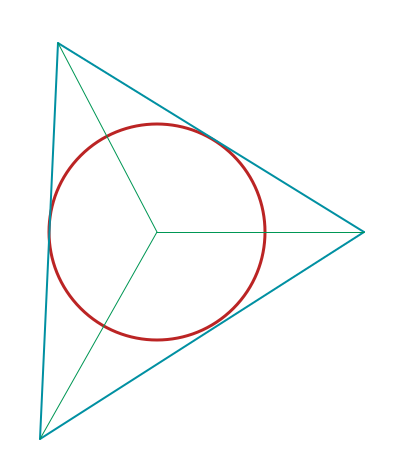Not enough information
 A triangle has an area of
1
0
4
3
c
m
2
and its inradius has a length of
5
4
c
m
. Find its perimeter in
c
m
. Also, if you can, find the relation between those three variables.
A triangle has an area of
1
0
4
3
c
m
2
and its inradius has a length of
5
4
c
m
. Find its perimeter in
c
m
. Also, if you can, find the relation between those three variables.
The answer is 10.75.
This section requires Javascript.
You are seeing this because something didn't load right. We suggest you, (a) try
refreshing the page, (b) enabling javascript if it is disabled on your browser and,
finally, (c)
loading the
non-javascript version of this page
. We're sorry about the hassle.
1 solution
We can prove that A = r s by drawing altitudes from the Incenter I to the sides A B , B C , and C A at points P , Q , and R respectively. Note that [ A B C ] = [ A I B ] + [ B I C ] + [ C I A ] = 2 1 ( I P ) ( A B ) + 2 1 ( I Q ) ( B C ) + 2 1 ( I R ) ( A C )
Note that I P = I Q = I R = r , so we have [ A B C ] = 2 1 r ( A B + B C + C A )
We see that [ A B C ] = A and A B + B C + C A = P . So A = 2 1 r P
However, 2 1 P = s . Thus, A = r s thus proved. □
Log in to reply
Nicely proved amazing.
This an excellent, elegant proof. Do you know where I can find more geometry proofs like these? And what is the code for the QED box symbol you used?
@Daniel Liu This is an elegant solution, but I still wonder how a triangle can have an area that is less than that of its incircle, (as 6 4 π > 4 3 ). Also, a triangle with this perimeter value, (as far as I can determine), would have a maximum area of only 5 . 5 6 0 0 to 4 decimal places. Any thoughts?
Log in to reply
Thanks for noticing that. I've added a statement to the problem.
Sorry, I've changed the values, so this triangle is now possible.
This problem is actually flawed. Even if the triangle has the equal sides (maximum inradius), the inradius can only have a length ~2.87669 cm.
The incircle could have burst already in the triangle. Boom!
Nice solution quite an easy problem.By the way do you attend science bowl and if you do what resources do you use to study @Daniel Liu
By using the relation A = r s , where A is the area, r is the inradius, and s is the semiperimeter, we arrive at the result that s = 8 4 3 .
Thus, the perimeter, P , is P = 2 s = 4 4 3 = 1 0 . 7 5